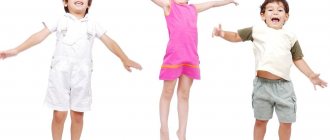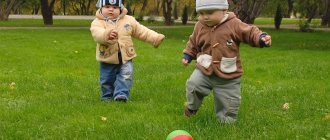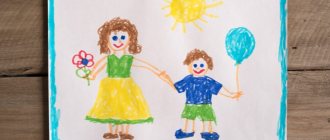School or kindergarten, clubs and sections, flows of information and new experiences, and even flows of demands from parents and teachers... It is not surprising that many modern children, even very young ones, are in constant stress. How to recognize its signs?
The word “stress” is of English origin; translated it means “pressure, load, tension.” It occurs as a result of intellectual and emotional overload.
While adults can recognize symptoms of stress and seek help, children have a much harder time. The child does not understand what exactly is happening to him, does not know how to get rid of a bad mood. Therefore, parents should be able to recognize signs of stress in time and help the baby cope with the situation.
Fears
If an ordinary child suddenly turns into a desperate coward, it means that he is clearly under stress. Parents should be alerted if a child closes doors everywhere, constantly checks whether the lock is locked, and turns on lights everywhere. He is already afraid not only of a dark room, but also of a picture on the wall, and noise on the stairs, and silence.
What to do? Actively involve your child in play, drawing - both of these activities are good for relaxing. With their help, try to understand, or quietly eavesdrop on the child’s conversations with toys.
Parents' confusion
When this difficult and difficult period for everyone comes, parents are lost and do not know how to behave and how to react to all this. Even if this is not the first baby in the house, the situation in the family is still tense. And it becomes unbearable for family members to live in such a difficult atmosphere: a nervous child, constant hysterics, strained relationships between household members.
Unfortunately, a family that is faced with such problems rarely seeks advice and help from a specialist. And most often he turns to various forums and his friends for advice. The advice of such acquaintances varies. And no one is safe from receiving “toxic” advice. In such cases, people advise frightened parents to “ask well so that they know for the future.”
Photo on Unsplash
But here it should be remembered that such a method will not only not bring good results, but will also break the trusting relationship between the baby and the parent. Thus, by resorting to such methods of education, parents make the child more and more nervous. And his behavior is deteriorating more and more, and now his parents’ nerves are on edge...
Aggressiveness
If you notice that your baby, who was previously so docile and friendly, suddenly began to be rude, answer sharply, throw toys and books at the wall, swing at others, know that these are signs of stress.
What to do? Aggression cannot be prohibited; it is better to try to translate it into other forms: learn to defend one’s rightness, analyze the situation together. Look for a constructive outlet for the child’s pent-up energy: active sports, outdoor games with other children, start a puppet fight.
4. Mood swings
The child is sometimes touchy for no reason, can easily cry over an insignificant reason, or, on the contrary, becomes too aggressive. Older children or depressed, depressive mood that lasts for days, weeks - all this should also alarm parents.
What to do? Have a heart-to-heart talk with your child and find out what is causing him concern. Teach him to understand and constructively express his emotions. Pay attention to even the smallest achievements. Monitor your child's daily routine, diet and sleep.
Increased fatigue. The child gets tired quickly
In most cases, increased fatigue and exhaustion of the child’s nervous system has very specific causes and is quite easy to correct or treat.
It is very important to understand and find the reasons why fatigue occurs. Treatment must precisely target the cause of the problem. Unfortunately, we often see the opposite examples. For example, a child gets tired due to a chronic infection, and he is taken to a psychologist and “behavior is corrected,” or, for example, the cause of fatigue is related to hormonal levels, and he is sent to a psychiatrist and prescribed medications that are unnecessary in this case. The opposite situation is possible: the child does not have any special health problems, but only psychological problems that lead to fatigue. It is necessary to clearly understand the reason for what is happening, and only then the treatment will bring the desired result.
A child's abrupt switching from active and dynamic games to complete loss of strength, in which the child can fall asleep in one minute, is the norm for children from two to five years old.
At this age it will be absolutely normal fatigue followed by a transition to activity.
Increased fatigue should alert you if:
- The child is so tired that he cannot concentrate, lags behind his peers in learning and mastering new skills;
- The child cannot sleep or wakes up at night, feels drowsy during the day;
- In the morning the child wakes up tired, has difficulty turning on, refuses breakfast;
- The child often suffers from colds;
- You notice a prolonged (more than 2 weeks) general lethargy in the child, dark circles under the eyes and pallor, a decline in mood;
- The child is in a negative mood most of the time, gets offended and cries for no objective reason;
- Drowsiness, apathy and indifference to previously favorite activities appear;
- The child complains of headache or dizziness;
- The child loses motor dexterity, shows aggression, and often changes positions when reading or doing homework;
- The child complains of fatigue and/or pain in the legs.
Increased fatigue is mainly due to the fact that the child's nervous system cannot maintain arousal long enough to support everyday tasks, including learning, mastering skills, speech, and so on.
A tired child finds it difficult to maintain attention on one thing, it begins to dissipate, as a result of which the child resists learning, which turns out to be too difficult for him. The situation develops into conflicts, and the reason for this is increased fatigue.
- Exhaustion of the child’s nervous system due to prolonged stress,
i.e. “getting stuck” of the body in a state of preparation for responding to danger. The stress response is designed by nature to be short-term; it comes to quick realization and a way out of stress. But if suddenly the stress readiness in the child’s body becomes long-term, the nervous system is gradually depleted. Thus, brain exhaustion occurs and, as a result, rapid fatigue. - Sleep disturbance .
Normal healthy sleep consists of four stages, of which the deepest and most important are the 3rd and 4th. With a deficiency of deep stages of sleep, nervous exhaustion occurs quite quickly. Frequent variants of sleep deprivation in children: the child has a normal sleep duration, but sleeps superficially, the child sleeps with awakenings, the child has shortened sleep (falls asleep for a long time or wakes up too early). Some sleep problems can be clarified by performing overnight EEG monitoring. - The presence of increased intracranial pressure
, when the brain is pressured by an excessive amount of cerebrospinal fluid and cannot remain in a state of excitement for a long time. - Chronic diseases,
and very often these are metabolic disorders, infections (adenoids, chronic tonsillitis), decreased thyroid function or other endocrine imbalance. Chronic infections can be associated with the herpes virus, streptococci, which very often cause such chronic fatigue. In this case, we will suggest that you put the child’s immunity in order, treat infections, and then the health of the child’s nervous system will be restored.
Health problems
Parents are often confused by inexplicable symptoms: vomiting, rash, fever, abdominal pain and other oddities - all this can happen due to nervousness if the child is very worried.
What to do? First, establish the psychological climate in the family, check whether the demands of family and school are not too different. They must be clear and consistent. Ideally, you should work with a child psychologist on the child’s self-esteem and be sure to check whether your son or daughter has personal time and space.
Two types of children's tantrums
Some teachers and psychologists distinguish between two fundamentally different types of hysterics in children: true and manipulative. This classification is based on the criterion of a child’s awareness of his behavior.
- True hysterics occur involuntarily. Emotions completely take over the baby, so he is not able to control his actions, take into account their possible consequences, or accept the persuasion and arguments of adults. The lower parts of the brain (in particular, the amygdala) are involved in the occurrence of this type of hysteria.
- Manipulative hysterics occur consciously (the upper parts of the brain are involved in the work). They are usually typical for children of middle and older preschool age. In this way the child wants to achieve the desired result. Indeed, when the baby is in a hysterical state, especially if this happens in a crowded place or if they need to rush somewhere, parents often find no other way out of the situation other than to instantly satisfy the baby’s need (or whim). If adults succumb to such manipulations at least several times, most likely, this model of behavior will be firmly entrenched in the preschooler.
When faced with manipulative hysteria, or “top floor” hysteria, it is important not to succumb to provocations and make it clear to the child that this method of getting what they want is not constructive. When the child understands that a tantrum is not effective, he will stop behaving in this way. If a child’s hysteria occurs unconsciously (a “lower floor” hysteria), first of all you need to support the child and accept his emotions. When the emotional outburst subsides a little, the baby will be able to perceive your words.
Distinguishing one type of tantrum from another can be difficult. But every parent knows their child well and can observe what is the reason and reason for hysteria.
Decreased academic performance
The fact that a child is in a poor psycho-emotional state is indicated by such signs as impaired memory functions, difficulties with imagination, poor concentration, loss of interest in everything that previously aroused curiosity.
What to do? Take an interest in the children’s school affairs every day. “What are the grades?”, ask about his feelings, mood, support him. Do not skimp on praise, notice even the most insignificant achievements of the child. If possible, help your child complete difficult tasks.
8. Fatigue
, difficulties with studying, which used to be easy. The child gets tired quickly after exercise, is absent-minded, forgetful, and restless.
What to do? Find out about childhood experiences and emotions. To help your child feel supported, make sure he knows that you are available any time he wants to talk to you about his problems. Appreciate your child in all situations and hug as often as possible.
Therapy for TR
Treatment of TD in children and adolescents is based on an integrated approach using methods of psychotherapy (rational, cognitive-behavioral, family, play, etc.) and pharmacotherapy. An important role belongs to parents who, following the recommendations of a specialist, help their child cope with anxiety. When coping skills and courageous behavior are practiced and encouraged at home, children and adolescents learn to face their fears, take smart risks, and gain confidence in their own abilities.
In pharmacotherapy, drugs of several groups are used, including non-benzodiazepine tranquilizers (hydroxyzine), tranquilonotropics (aminophenylbutyric acid hydrochloride), drugs with sedative and vegetative-stabilizing effects (affinity-purified antibodies to the brain-specific protein S-100), selective serotonin reuptake inhibitors (fluvoxamine, sertraline), mild antipsychotic drugs (alimemazine), herbal medicines. It should be noted that there is a need for long-term medical supervision and long-term therapy.
For children and adolescents with various forms of TR, complex medications may be recommended, including neurometabolic agents, vitamins, macro- and microelements. Such a drug is “KidZ syrup with lemon balm and mint,” which is prescribed in courses of 2 weeks. in the following doses:
child from 3 to 7 years old - 5 ml 2 times a day;
child from 7 to 11 years old - 5 ml 3 times a day;
for a child over 11 years old - 10 ml 2 times a day.
The composition of the drug “KidZ syrup with lemon balm and mint” includes useful and safe components (B vitamins, amino acids, magnesium, zinc and plant extracts) that normalize the functioning of the nervous system, restoring the natural balance between the processes of excitation and inhibition:
lemon balm and mint in the form of extracts help eliminate nervous tension;
choline (a precursor to the neurotransmitter acetylcholine) is involved in the formation of components of brain tissue, helps improve memory and performance;
glycine has a beneficial effect on motor skills and speech, helps reduce psycho-emotional stress, aggressiveness, and conflict;
lysine protects brain cells from oxygen starvation, slows down excitation processes;
vitamin B1 (thiamine) ensures metabolic processes in the central nervous system (CNS), affects the functions of neurotransmitters (acetylcholine, GABA), the processes of nerve impulse conduction;
vitamin B3 (niacin, nicotinamide) ensures the occurrence of redox processes in the body and the normal functioning of the central nervous system;
vitamin B6 (pyridoxine) is involved in the biosynthesis of neurotransmitters (GABA, serotonin, catecholamines, etc.);
magnesium is a central element that maintains the balance of excitation and inhibition processes in the central nervous system. Magnesium is necessary to stabilize the activity of excitatory (glutamate) receptors. It is a cofactor of adenylate cyclases involved in signal transmission from dopamine, serotonin and adrenaline receptors to control intracellular cascades, as well as a cofactor of catechol-O-methyltransferase, which inactivates excess monoamine neurotransmitters;
magnesium and vitamin B6, when administered together, help improve behavior, reduce anxiety and aggressiveness, and increase concentration;
zinc is involved in ensuring mental processes, since it is part of all known classes of enzymes and is involved in the metabolism of proteins, fats, carbohydrates and nucleic acids. Zinc is necessary for the processes of neuroontogenesis, is part of brain metalloproteins that have neuroprotective properties, and is involved in the mechanisms of learning and memory.
Insulation
A state of psychological stress can manifest itself in a child in a desire for loneliness. He stops participating in the games of his peers and has difficulty maintaining discipline.
What to do? First you need to deal with the stressful situation; if the child does not currently have the resources to communicate, there is no need to insist. If he wants to, help your child make friends with one child first: go to the park or to the theater together. Children's communication trainings (for example, group sand therapy classes) are an excellent way to cope with this problem.
Compulsive symptoms
Indicators of a stressed state in a child include winding hair around fingers, as well as coughing, trembling hands, shaking the head, twitching of the shoulders, playing with the genitals, bedwetting and even daytime urinary incontinence, and stuttering.
What to do? Adequate physical activity can help a child survive stress: daily walks, jogging, cycling, morning exercises. The child should have the opportunity to express his emotions and fully rest, relax after a hard day.
If the situation gets out of control, do not neglect the help of a child psychologist and neurologist.
Each of the signs listed above may indicate that the baby is under stress. Be attentive to your child: if parents ignore these alarming signals, this can not only lead to permanent health problems in the baby (for example), but also affect the formation of his personal qualities.
Increased anxiety in a child
The main reason
Anxiety in a child is the constant presence of the nervous system in a protective adaptive reaction to external situations and circumstances that the child for some reason assesses as dangerous (stress reaction). The child may not be aware of them, since he grows up in them from birth, and he is used to them, but subconsciously feels restless and unsafe.
Common symptoms of increased anxiety in a child:
- Anxiety in a child is often manifested by excessive attachment to the mother, since for the child she is the natural source of calm.
- Increased anxiety may be accompanied by excitability and hyperactivity, or, conversely, exhaustion of the nervous system, depression and apathy of the child. The brain cannot maintain anxiety and excitement indefinitely and quickly becomes exhausted.
- Very often, excessive anxiety is accompanied by immune depression (secondary immune deficiency due to stress) and frequent illnesses. For example, a child is highly susceptible to colds, brings all the infections that appear there from kindergarten, and spends a long time at home undergoing treatment.
- An almost obligatory and most common manifestation of increased anxiety is sleep disturbance; the child has trouble falling asleep and often wakes up. Or, at first glance, he sleeps enough and a lot, but does not get enough sleep and gets up in the morning in a bad mood.
- Fears (invents and endows safe things with dangerous properties).
First of all, it is necessary to understand in which area the causes of the problem lie. In psychological or medical
.
- Increased anxiety as a psychological problem.
- Anxiety in a child due to medical problems. This could be long-term brain damage during childbirth, hypoxia, asphyxia or birth trauma, after which the brain itself begins to generate anxiety in response to external circumstances. This may be increased intracranial pressure; in more complex situations, the causes may be autistic disorders, childhood psychoses, or even schizophrenia. And in order to help a child as effectively as possible, you need to accurately determine the nature of anxiety.










